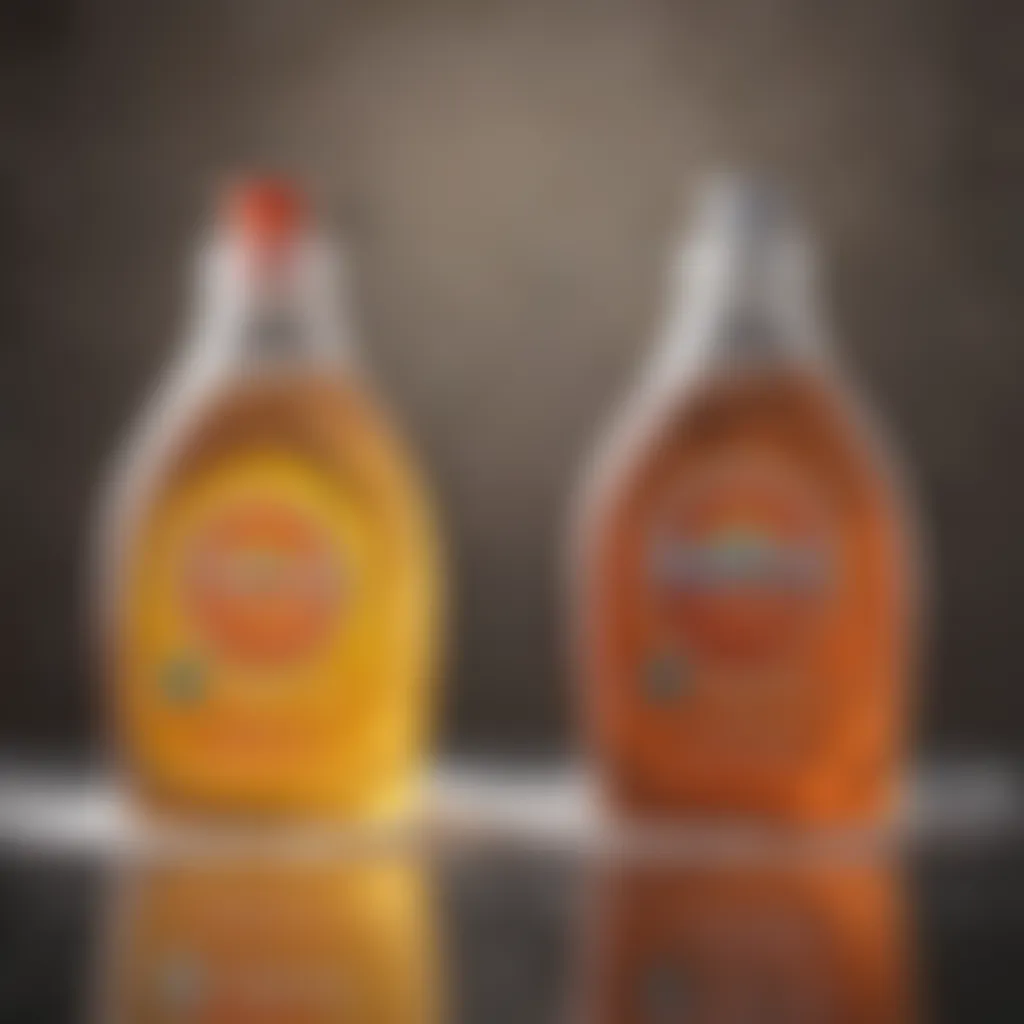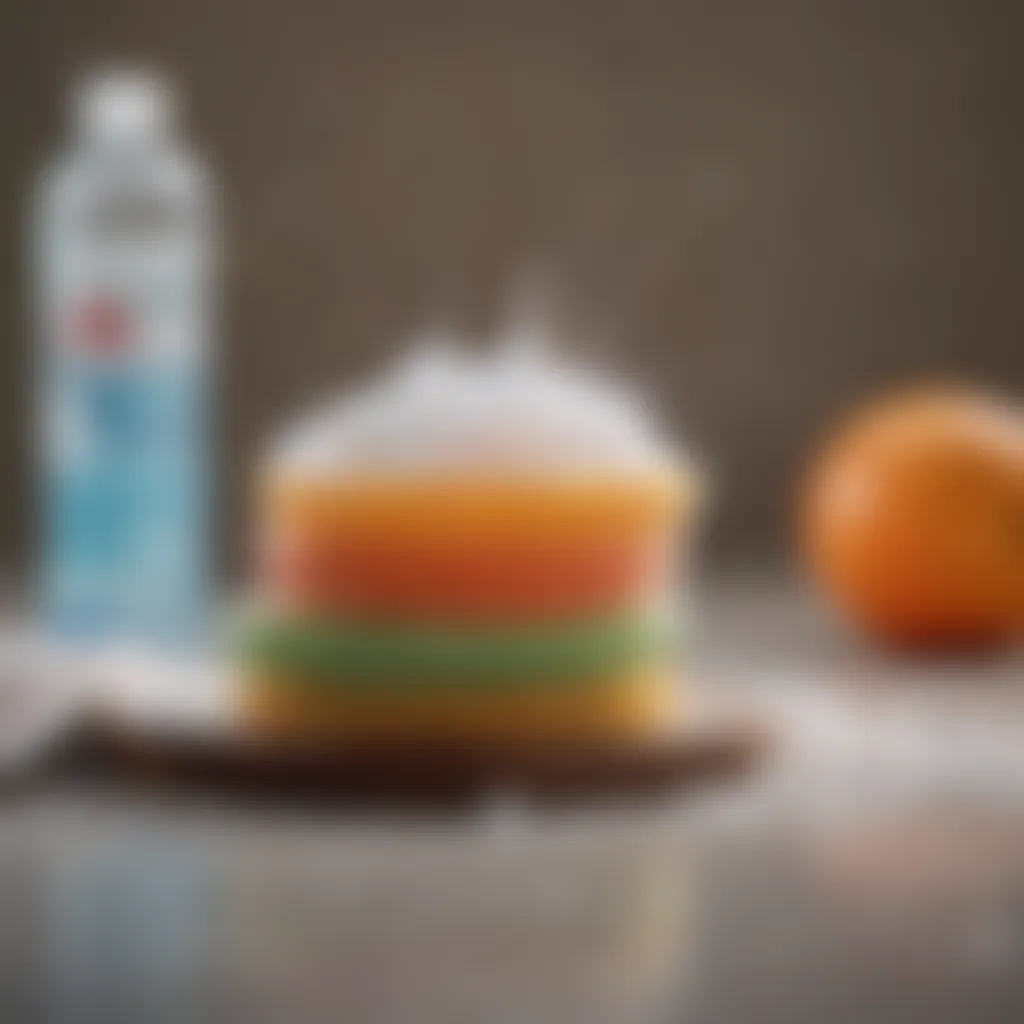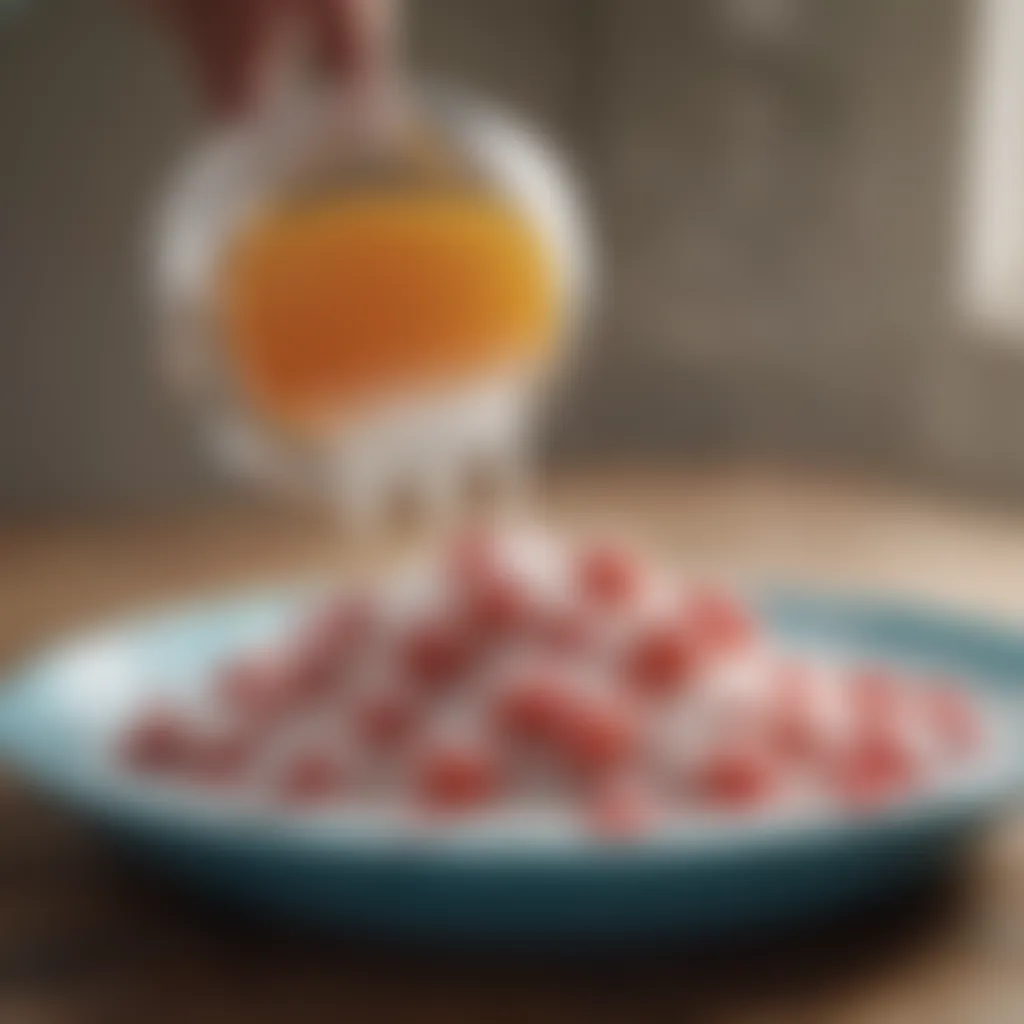Innovative Uses of Baking Soda and Dish Soap


Intro
Baking soda and dish soap are versatile ingredients found in almost every household. Their uses extend far beyond simple cleaning tasks, offering solutions in culinary practices, personal care, and even sustainable living. Understanding their properties and interactions can lead to improved results in daily activities.
This article aims to explore the various applications of these two common substances. We will delve into their functions, safety considerations, and effective combinations. In doing so, we hope to equip readers with a deeper knowledge of how baking soda and dish soap can enhance their routines.
Intro to Baking Soda and Dish Soap
Baking soda and dish soap are common household items that hold much potential beyond their standard uses. Understanding these products can drastically improve your cleaning routines and personal care practices. This section delves into the foundational aspects of baking soda and dish soap, clarifying their definitions, compositions, and historical significance.
Definition and Composition
Baking soda, also known as sodium bicarbonate, is a white crystalline compound. It is widely used as a leavening agent in baking. Its mild alkalinity helps react with acids, producing carbon dioxide gas that makes baked goods rise. On the other hand, dish soap, the name commonly given to liquid detergent, contains surfactants. These are compounds that reduce the surface tension of water. This action allows the detergent to penetrate food particles and grease, making it easier to wash dishes.
When combined, baking soda and dish soap offer unique cleaning properties. Baking soda acts as a gentle abrasive, while dish soap effectively breaks down greasy residues. This combination not only enhances cleaning efficacy but also presents a natural alternative to chemical cleaners.
Historical Context
The journey of baking soda and dish soap can be traced back centuries. Baking soda’s origins date back to ancient Egypt, where it was used for various purposes, including cleaning and personal care. It became popular in the 19th century when its leavening properties were recognized in baking. The development of modern dish soap began around the mid-20th century. As households sought efficient cleaning solutions, the demand for versatile detergents grew.
The evolution of these products reflects societal changes towards convenience and safety in household practices. Over time, they have been refined to meet the needs of consumers, especially in light of increased awareness about health and environmental impacts of cleaning products. Today, baking soda and dish soap are staples in many homes worldwide, largely due to their affordability and effectiveness.
Both baking soda and dish soap embody the essence of simplicity, yet they pack significant cleaning power and versatility.
Cleaning Power of Baking Soda
Baking soda, known chemically as sodium bicarbonate, is an essential multi-purposed item that many homes have. Its significance in cleaning derives from its unique combination of chemical properties that make it highly effective against a range of stains, odors, and grime. Understanding its cleaning power enriches this article by providing insights into how such a simple compound can contribute to household hygiene.
Chemical Properties
Baking soda has alkaline properties, which means it can neutralize acids. When it interacts with acids, it undergoes a reaction that releases carbon dioxide. This property is central to its cleaning power. The reaction helps lift dirt and grime from surfaces. The mild abrasiveness of baking soda is also critical. It allows for effective scrubbing without scratching delicate materials.
It can also dissolve grease, making it valuable in kitchen cleaning. Its pH neutralization helps maintain an environment that is less conducive to bacterial growth. Thus, baking soda is not only a cleaner but also an aid in maintenance of hygienic conditions in the home.
Surface Abrasion and Stain Removal
One notable feature of baking soda is its capability for surface abrasion. This means it can gently scour surfaces without causing damage. When faced with tough stains or stuck-on residue, a paste made from baking soda and a bit of water can be applied directly. The combination works wonders on various surfaces like countertops, bathroom tiles, and even dishes.
To remove stains, follow these simple steps:
- Mix baking soda with water to form a thick paste.
- Apply the paste to the stained area.
- Allow it to sit for some time to penetrate.
- Scrub gently and rinse well.
This process is particularly effective on fabric, carpets, and upholstery, allowing for a deeper clean that lifts stains without harsh chemicals.
Odor Neutralization
Odor neutralization is another important function of baking soda. Many household odors stem from acidic compounds – baking soda's alkaline nature neutralizes these. This is particularly useful in areas like the refrigerator or trash bins, where smells can linger.
To use baking soda for odor removal, consider these methods:
- Sprinkle baking soda in the bottom of trash bins to absorb smells.
- Place an open box in the refrigerator to combat food odors.
- Add a cup of baking soda to your laundry to help eliminate odors in clothes.
By regularly applying baking soda, you can effectively manage unpleasant smells, keeping your environment fresh.


"Baking soda is not just a leavener in recipes but a powerful and versatile cleaning agent."
Effectiveness of Dish Soap in Cleaning
Dish soap is an essential household item known for its powerful cleaning properties. Its versatility extends beyond mere dishwashing, making it a staple in many cleaning routines. Understanding the specific elements and benefits of dish soap enhances its effective use. It is formulated to tackle various substances, particularly those that are difficult to remove.
Surfactant Action
The effectiveness of dish soap largely comes from its surfactant properties. Surfactants are compounds that reduce the surface tension between liquids, allowing for better interaction. When dish soap is mixed with water, it breaks down oils and grease, making it easier to clean surfaces. This action occurs because the soap molecules have two different ends: one that is hydrophilic (attracted to water) and one that is hydrophobic (repellent to water but attracted to oils).
This unique structure allows dish soap to latch onto and pull away dirt and grime. It effectively emulsifies greasy substances, preventing them from sticking to surfaces, which is essential for achieving thorough cleanliness. This property is particularly beneficial when dealing with baked-on food residues, which can be stubborn to clean otherwise.
Grease and Oil Removal
Grease and oil are common challenges in household cleaning, especially in the kitchen. Dish soap shines in this regard, as it effectively cuts through these substances. This makes it an ideal choice for cleaning pots, pans, and cutting boards that have been used for cooking. When dish soap is applied, it breaks down the molecular structure of grease, allowing water to wash it away easily.
Some key tips for removing grease and oil using dish soap include:
- Apply directly: For tough stains, apply the soap directly onto the greasy area and let it sit for a few minutes before scrubbing.
- Use hot water: Hot water increases the effectiveness of dish soap, helping to dissolve grease more effectively.
- Combine with baking soda: For extra cleaning power, mix dish soap with baking soda to form a paste that can tackle even the most stubborn grease.
In essence, the combination of surfactant action and the ability to remove grease positions dish soap as a vital component in effective cleaning.
"Understanding the science behind dish soap can turn ordinary cleaning tasks into efficient results."
By leveraging these properties and techniques, anyone can enhance their cleaning strategies and achieve better results in less time.
The Synergy of Baking Soda and Dish Soap
The combination of baking soda and dish soap creates a powerful cleaning agent. Individually, both substances have useful properties. However, when they come together, they enhance each other's effectiveness. This synergy not only improves stain removal but also promotes a more efficient cleaning process. Understanding how these components work in tandem can significantly impact various cleaning tasks at home.
Understanding Chemical Reactions
The interaction between baking soda and dish soap is rooted in basic chemistry. Baking soda, or sodium bicarbonate, is a mild alkali. This means it can react with acids to produce carbon dioxide gas, which creates bubbling action. Dish soap, on the other hand, contains surfactants. Surfactants lower the surface tension of water, making it easier for it to spread and penetrate dirt and grease.
When mixed, these two substances can tackle tough stains, particularly those caused by grease or oil. The alkaline nature of baking soda helps neutralize acidic stains, while the surfactants in dish soap lift dirt away from surfaces. The result is a cleaning solution that can be more effective than using each ingredient separately.
Formulating an Effective Cleaner
Basic Recipe for Household Use
Creating a basic cleaner with baking soda and dish soap is straightforward. The simple mixture of these two ingredients can effectively handle a range of cleaning tasks. To make this cleaner, one would typically combine three tablespoons of baking soda with a few drops of dish soap and a cup of warm water. This blend turns into a paste, which is excellent for scrubbing surfaces.
This recipe is popular due to its gentle yet effective nature. It can safely clean countertops, sinks, and other surfaces without causing damage. The key characteristic of this recipe is its minimal use of harsh chemicals, making it a favorable choice for households concerned with safety and environmental impact.
Proportions for Different Applications
The proportions used in this mixture can be adjusted based on the specific application. For tougher stains or more heavily soiled areas, increasing the amount of baking soda may yield better results. A higher concentration can enhance the abrasive qualities of the paste, allowing it to scrub away stubborn grime more effectively.
Conversely, for a lighter cleaning task, using less baking soda and more water can provide a gentler solution. This versatility is one of the major advantages of using this combination. However, care should be taken not to alter the proportions too dramatically, as this may reduce effectiveness in achieving the desired cleaning results.
In summary, the synergy between baking soda and dish soap offers a compelling and efficient solution for home cleaning tasks. Their specific chemical properties work together, creating a versatile cleaner that adapts well to many surfaces and challenges.
Practical Applications for Home Cleaning
Baking soda and dish soap are staples in many households, valued for their versatility and effectiveness. This section discusses their practical applications for home cleaning, showcasing how these common ingredients can simplify routines and enhance cleaning performance. Their combined use can tackle a variety of cleaning challenges, making them integral to household maintenance. Utilizing these items not only helps to maintain cleanliness but also promotes sustainable living by reducing dependence on harsh chemical cleaners.


Kitchen Cleaning Solutions
In the kitchen, maintaining hygiene is of utmost importance. Baking soda serves as a mild abrasive, making it effective for scrubbing pots, pans, and counters. Combining it with dish soap creates a powerful cleaning paste that can handle tough stains and grime. A simple mixture of two parts baking soda and one part dish soap can help clean greasy messes or burnt residues.
Also, consider soaking sponges and dishcloths in a solution of baking soda and water. This not only deodorizes them but also aids in their disinfection.
- Preparation of Cleaning Paste: Mix baking soda and dish soap until you achieve a thick consistency.
- Application: Apply the paste to the stained area using a cloth or scrubber. Let it sit for a few minutes before scrubbing.
- Rinse Thoroughly: Always rinse the surface with water to remove residue.
Bathroom Usage
Bathrooms require regular cleaning due to moisture, which promotes mold and mildew growth. Baking soda excels in absorbing odors, making it an excellent choice for deodorizing bathrooms. When mixed with dish soap, it can eliminate stubborn soap scum and hard water stains.
Create a cleaning solution by adding baking soda to dish soap and some vinegar. This combination helps to break down tough buildups on faucets, showerheads, and tiles, ensuring that your bathroom remains fresh and clean.
- Simple Recipe for Bathroom Cleaner:
- 1 cup baking soda
- 1/2 cup dish soap
- 1/2 cup vinegar
Be cautious while using vinegar, as it can sometimes damage certain surfaces. Always test on a small area first.
Laundry Enhancements
Both baking soda and dish soap can enhance laundry performance. Adding baking soda to laundry helps to boost detergent efficacy. It increases the alkalinity of water, which aids in breaking down stains and odors in clothing. A half cup of baking soda added to a regular load can make a noticeable difference.
Additionally, dish soap can work well on greasy stains, like oil or food spills on fabrics. Apply a few drops directly to the stain, let it sit for a few minutes, then wash as usual. This method is especially effective for collars and cuffs.
In summary, the practical applications of baking soda and dish soap extend beyond ordinary cleaning tasks. Their synergy not only addresses various cleaning challenges but also fosters a commitment to environmentally friendly practices. Making the most of these readily available ingredients opens the door to effective and sustainable cleaning solutions.
Personal Care Applications
Personal care is an area where baking soda and dish soap can have significant benefits. These substances serve a variety of roles beyond just cleaning household items; they can enhance personal hygiene, improve skincare routines, and even contribute to oral health. Understanding these applications is important for maximizing their potential in everyday life.
Exfoliating Scrubs
Baking soda is a gentle abrasive, making it effective for use in exfoliating scrubs. These scrubs help to remove dead skin cells, promoting smoother and healthier skin. The fine particles of baking soda can easily lift away impurities without causing irritation. To create an exfoliating scrub, mix baking soda with a small amount of water to form a paste. Apply this mixture to damp skin and gently scrub in circular motions. It is advisable to follow this with a moisturizer to retain skin hydration.
Dental Care
Baking soda's role in dental care is notable. It acts as a mild abrasive that can help remove surface stains from teeth when used in moderation. Many commercial toothpaste products include baking soda for this reason. For a simple at-home remedy, mix a teaspoon of baking soda with water to form a paste. Use this mixture to brush your teeth once a week. This can help maintain whiteness and freshen breath. However, care should be taken not to overuse, as excessive abrasion can wear down tooth enamel.
Soothing Skin Irritations
Baking soda can also be beneficial for soothing skin irritations such as insect bites or mild rashes. Its anti-inflammatory properties provide relief from itching and discomfort. To use, dissolve baking soda in lukewarm water and soak a clean cloth in the solution. Place this cloth on the affected area for about 15 minutes. This method can bring soothing relief, helping to reduce redness and irritation.
"The versatility of baking soda makes it a valuable addition to personal care routines, offering a natural alternative for common issues."
Understanding these personal care applications not only enhances daily routines but also encourages the use of natural, effective solutions that can be easy to prepare and apply. Incorporating baking soda into personal care practices is a step towards a holistic approach to well-being.
Culinary Uses of Baking Soda
Baking soda, chemically known as sodium bicarbonate, has a significant role in culinary practices. Its versatility in the kitchen extends beyond mere leavening. Understanding its properties and functions as a baking ingredient can greatly enhance the results of various dishes. This section emphasizes the dual roles of baking soda: as a leavening agent and in regulating pH levels, both critical for achieving desired textures and flavors in food preparation.
Leavening Agent in Baking


One of the primary functions of baking soda is its ability to act as a leavening agent. When mixed with an acid, baking soda generates carbon dioxide gas. This gas is crucial for creating the light and fluffy texture in baked goods such as cakes, muffins, and cookies. The release of carbon dioxide bubbles expands the batter, causing it to rise.
Key points about baking soda as a leavening agent include:
- Fast Action: Unlike baking powder, which contains a mix of acid and base, baking soda requires an acid to activate. Common acidic ingredients include lemon juice, buttermilk, or even yogurt.
- Proper Measurements: Using too much baking soda can lead to a soapy taste, whereas too little may result in dense baked goods. Precise measurement is vital.
- Timing: Once activated, baking soda starts working immediately. It is best to bake batter right after mixing to achieve maximum rise.
Baking soda is most effective when paired with acidic ingredients that can trigger its leavening properties.
pH Regulation in Recipes
Another important culinary use of baking soda lies in its ability to regulate pH in various recipes. The alkalinity of baking soda can impact not only the flavor but also the texture of food. For instance, when baking soda is added to recipes for certain vegetables, it can help retain their vibrant colors by neutralizing acidity.
Considerations for using baking soda in pH regulation:
- Vegetable Preparation: Adding a pinch of baking soda to water when boiling vegetables can keep their colors bright, such as in the case of green beans or peas.
- Bread Dough: When making bread, a small amount can enhance the browning of crusts during baking, resulting in a visually appealing product.
- Adjusting Acidity: In recipes where acidity is undesirable, baking soda can neutralize it. This is particularly useful in sauces and marinades that may taste overly tart.
Using baking soda thoughtfully can enhance culinary creations significantly. From leavening baked goods to regulating pH for improved color and flavor, its uses are numerous and impactful.
Environmental and Safety Considerations
In the realm of household cleaning and personal care, understanding the environmental and safety considerations of using baking soda and dish soap becomes increasingly important. This section addresses the necessity to consider not just how effective these common products are, but also their impact on our planet and personal well-being. Choices about the products we use directly affect the environments we inhabit. By utilizing basic ingredients like baking soda and dish soap, consumers can alleviate feelings of concern over both safety for themselves and sustainability for the earth.
Sustainability of Using Basic Ingredients
The sustainability of using baking soda and dish soap stems from their simple, non-toxic compositions. Both ingredients are biodegradable, meaning that they break down naturally in the environment without leaving harmful residues. This reduces the likelihood of contributing to the pollution that often accompanies many conventional cleaning products.
When using natural items, households can lower their carbon footprint. Here are few key points regarding their sustainability:
- Minimal Packaging: Products like baking soda often come in simple paper or cardboard packaging.
- Versatility of Use: By serving multiple roles—from cleaning to baking—these ingredients reduce the need for buying numerous specialized products.
- Availability: Both baking soda and dish soap are widely available, often at lower prices than niche cleaning products.
"Adopting natural and multipurpose products can significantly ease the strain on both personal finances and the environment."
Incorporating these basic ingredients into daily routines supports a shift towards more sustainable living. As households make informed choices, their impact becomes part of a larger conversation about eco-friendly practices.
Safety Precautions
While baking soda and dish soap are generally safe for use, precaution is still necessary. Here are some considerations to follow:
- Avoid Mixing Chemicals: Never mix dish soap with bleach or other household cleaners, as harmful gases may form.
- Child Safety: Always store these items out of reach of children to prevent accidental ingestion.
- Skin Sensitivity: While baking soda is typically gentle on the skin, some individuals may experience irritation. Test on a small patch before widespread use.
Epilogue and Future Insights
In this exploration of baking soda and dish soap, we have revealed the versatility and practicality of these common household items. As the concluding segment of this article, it is essential to recognize the significance of these elements in maintaining a cleaner home and a more sustainable lifestyle. These products not only serve practical purposes but also empower individuals to engage in eco-friendly practices.
Understanding the key benefits discussed previously enables users to apply baking soda and dish soap effectively. These substances are not merely for cleaning; they can enhance culinary experiences and support personal care routines. This versatility reflects their place in modern domestic life, making them staples in various applications.
Moreover, considering future insights into innovative uses allows for continuous exploration. This adaptability signifies that baking soda and dish soap can evolve with consumer needs and emerging sustainable practices. By adopting these methods, we can contribute to environmental wellbeing while ensuring safety in our household chores.
Recap of Key Benefits
- Cost-Effective Solutions: Both baking soda and dish soap are affordable and widely available. They serve multiple roles without requiring expensive specialized products.
- Eco-Friendly Ingredients: Derived from natural sources, these substances minimize harmful chemicals in the home, contributing to cleaner living spaces.
- Ease of Use: Their applications are straightforward, appealing to those looking for simple yet effective cleaning solutions. The processes often require only mixing with water or combining in specific ratios.
- Versatility Across Applications: From cleaning surfaces to acting in personal care, their range of uses is impressive. Users can integrate them seamlessly into cooking and cleaning routines.
Potential for Innovative Uses
The potential for innovative uses of baking soda and dish soap is vast. As trends toward sustainability and health continue to rise, further exploration of these products is warranted. Here are some avenues worth considering:
- DIY Household Cleaners: Embracing a do-it-yourself mindset can lead to custom cleaning solutions that leverage the properties of baking soda and dish soap while avoiding commercial chemicals.
- Natural Deodorizers: With their odor neutralization properties, these products could be experimented with in various settings, such as pet care or home odor control.
- Gardening Applications: Research can investigate using these ingredients in organic gardening for pest control or soil health improvement.
- Personal Care Innovation: Continued exploration in personal care products can provide alternative solutions to synthetic ingredients, keeping health and skin sensitivity in mind.
Innovation does not necessarily mean creating something brand new; it often involves combining existing solutions in novel ways.
By taking advantage of ongoing research and changing consumer demands, the applications for baking soda and dish soap will likely expand. The future is promising, especially as society seeks healthier and more sustainable choices.







